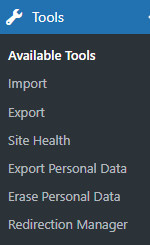It is a good idea to familiarize yourself with the WordPress Dashboard because, in the beginning, you will be spending a lot of time here.
Regardless if your site is a money-making site or just a hobby, learning the basics of the WordPress dashboard will put you ahead.

As time goes on, this probably won’t change unless you hire a website consultant/developer to do your work for you. So let’s get to the WordPress Dashboard Menu—explained in easy terms.
The WordPress Dashboard (admin area) is like a home page or welcome page to what goes on behind the scenes and is commonly called the ‘back end.’ Every time you log in, you will see the WordPress Dashboard and all the areas you can access from the back end. Here is an image of what the WordPress dashboard menu looks like when you log in.
Screen Options on the WordPress Dashboard

At the very top of the WordPress Dashboard, at the top right, you will see Screen Options. This is where you can edit and control the WordPress admin area.
If you click on this, you will see a list of items with checkboxes beside them that you can choose to display on the dashboard every time you open it up. These include:
AIO SEO Setup
Site Health Status
At a Glance
Activity
AIO SEO Overview
SEO News
Quick Draft
WordPress Events and News
Welcome
Plus any other plugin you may have added, such as Elementor Overview, Site Kit Summary, Broken Link Checker, etc.
You can click on any of these to remove them from the screen when you first go to the dashboard. I don’t like having a lot of clutter or ‘noise,’ so I have mine set at Site Health Status, Site Kit Summary, and Broken Link Checker. You can pick and choose what you want to see at any time.
Updates
At the top are the Updates, which will tell you if you need to update plugins, themes, and the latest version of WordPress. It is always good to check here periodically and keep this up to date.
Posts
When you click on Posts, the dropdown menu provides you with the option to view or edit existing posts, create new ones, delete posts, and manage categories.
Media
The Media Library is where you can upload and manage new images, documents, audio, and videos in one specific area. You can also view, edit, or delete any existing media. There is a search box to locate images by typing in a word or phrase, which comes in handy if you have a lot of media files.
Pages
This is where you can click on the dropdown menu and view existing pages, create new pages, and edit or delete existing ones.
Comments

The comment section is where you can access any comments left on your website by a visitor. By clicking on Quick Edit, you have the option to approve or disapprove a comment, edit it, trash it, or mark it as spam. If the commentator has included his/her URL to his/her website, you can remove it.
Be sure to update or move to trash should you decide you want to delete the comment. Getting comments is a great way to engage with your visitors and followers.
Appearance
This is a section that you will visit quite often. It is where you can access:
- Themes (install, update, or delete)
- Customization of the current theme
- Widgets
- Menus
- Other customized settings
Plugins
A plugin is a piece of software that adds or enhances the functionality of your website. At a glance, you can see all your installed plugins, or you can install and activate new ones, or delete existing ones.
Users
The dropdown menu shows existing users of your WordPress website. You can also add new ones and assign a role such as a subscriber, contributor, author, editor, or administrator. Here you can also edit or delete existing users.
Tools

This tab contains the tools necessary to perform management tasks. Here you will find available tools, tools to import or export data from other platforms, tools to export or erase personal data, as well as tools to monitor the site’s health, such as speed and security.
Settings on the WordPress Dashboard

There is a lot you can do under settings, such as:
General Settings – configure site title, tagline, WordPress URL, Site URL, and email options
Writing—post formatting and categories
Reading—you can specify how many posts per page readers can see, RSS feed, full text or excerpt, and stop search engines from indexing the website
Discussion—notify any blogs linked to from the post, allow comments and other comment settings, e-mail notifications, moderation of comments
Media—uploading and management of images which includes sizes and cropping options
Permalinks—select the permalink format that you want for your posts and pages such as dates in your URLs or just titles and/or categories
Collapse Menu
If you click on this item, the menu is hidden with only the icons visible. Clicking again will expand the menu.
Conclusion
Familiarizing yourself with these features is a good idea, as you will be spending a lot of time in the backend of your website. Knowing the WordPress Dashboard Menu will help you to make the necessary changes to your website as needed and ensure it is kept up to date.
This post contains affiliate links, which means I may earn money from products and services you purchase through my links.
